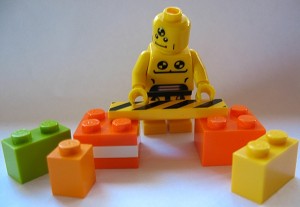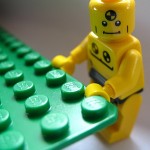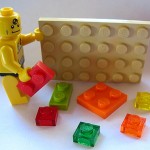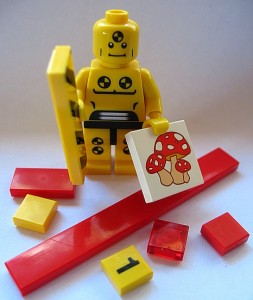
What are those “bumps” called on top of LEGO bricks? And how about the ones with no bumps? How do you refer to them?
It is a good idea to get familiar with some basic LEGO terms. This will help you to communicate easily with other Lego builders. It also becomes easier to locate pieces at online stores, or at least know what category they most likely belong to.
There are hundreds of different LEGO pieces; bricks, plates, tiles, doors, windows, fence pieces, wheels, slopes, arches, wedges, specialized pieces, etc. But let’s start with identifying the most basics; the bread-and-butter of LEGO.
STUDS: these are the little “bumps” on top of LEGO elements. These are what makes LEGO “stick” together.
BASEPLATES: are you building a LEGO house, or perhaps planning to create a whole town? How about a moon-base for your space-explorers? Baseplates are the foundation for the task!

These are thin plates, usually quite large, and you can build things on top of them. (They have no bottom connections.) They provide an excellent base – that’s why the name “baseplate” – for any medium to large size creation.
Some baseplates are very simple; with just studs to connect other pieces to. Other baseplates have outlines of roads, intersections, rivers, lakes, etc. And there are also very special baseplates with raised parts resembling rocks, hills, and other landscaping. These can make your creation more realistic.
BRICKS: the heart-and-soul of LEGO is the basic brick. They come in many different sizes and colors. You can attach other parts with studs on both the top and the bottom of a brick.
 PLATES: these are thinner then bricks (but not as thin as baseplates). In fact, if you stack 3 plates on top of each other, you get the height of one brick. (This is useful to know while you are building.) They can also connect to other parts both on top and at the bottom, just like bricks.
PLATES: these are thinner then bricks (but not as thin as baseplates). In fact, if you stack 3 plates on top of each other, you get the height of one brick. (This is useful to know while you are building.) They can also connect to other parts both on top and at the bottom, just like bricks.
TILES: these are thin, like plates, but they have no studs on top. They are excellent for floor-tiling, table-tops, and any other time when you want to create a smooth surface. They have connection points at the bottom, but not on top.

DECORATED PARTS: When bricks, plates, tiles or other parts have printed designs on them they are usually referred to as “printed” or “decorated” parts. These can ad a nice finishing touch to your creation.
MEASUREMENTS: LEGO-fans usually refer to parts not by inches or centimeters, but by the number of studs the part has. For example, a brick that has 2 studs on the short side and 4 studs on the longer side is called a 2×4 brick.
A plate with 4 studs on the short side and 8 studs on the long side is called a 4×8 plate. A baseplate that has 50 studs on all sides is called a 50×50 baseplate.
Even though tiles have no studs, they are still referred to by how many studs they would have. So a tile that is the same size as a 1×4 plate, will be referred to as a 1×4 tile.
If you familiarize yourself with these basic terms you will see that all other names for the more specialized parts are based on these.
For example, if you find a part that has the height of a brick, and has 4 studs on top, but it is round, it would be called a 2×2 round brick.
If you run across a piece that has the height of a plate, and has 1 stud, but there is a little clip sticking out at the side, it would be called a 1×1 plate with clip.
See, it is easy! 😉
Want to learn more? Head over to the ADVANCED TERMS section!












This is a helpful post, but please note that there are some variations to the terms used. For example the pick-a-brick section on Lego’s site uses different terms to some of the elements than Bricklink. So I think it would be a good idea to list some of the variations.
Great comment, brickhead! Thanks for bringing this to my attention! I should do a thesaurus on the possible variations!
Actually, knowing the proper terms helps kids learn math! At least that is my experience. They talk about 2×4 plates and such, they can easily visualize it and get a concept of what that means. Lego is a great education toy!
I always called the bums, bumps. So lame! Thanks for updating my vocabulary to a more civilized level! 😀
Nice! I already know of all these from my 3 years of collecting. btw , would 110 minifigures be good for a 3 year collection?
Tobymacboy, nice collection! What is a “good collection” is judged by you only. 😉
Some LEGO fans like to build MOCs and only use minifigures as an accessory – so they may have lots of sets and parts, but not that many minifigures. Others like to build armies, and have huge numbers of minifigures and not that many sets. So, it is totally up to you what you like. I have about 500 minifigures, because I like to build small fractions of armies and customize them to the hilt, but that is nothing compared to the collection of some people I know. 8)
Well i dont just buy minifigures. I own gigantic sets like the AT-AT , Apple tree house , Emperor palpatines shuttle , Turbo shredder ,Lavatraz , alien trash compactor , and hundreds of small sets. I do buy some mimifigure packs. Unlike some people , I don’t take apart my minifigures. I use them for stopmotion and there body parts already get loose enough from doing that. I would have more sets and minifigs , but my dad is totaly against my buying Lego. Even though he used to have them and loves to help my little bro build.
Toby, nice collection! 😀
go to to see my videos. some stopmotion , some actors. but they are all cool and funny
Toby, nicely done! Would you have youe videos on YouTube as well? This GodTube site loads increadibly slow. 🙁
sadly no. I and my parents are Christian and the have my cpu set up to block youtube. G0dtube does run slow but it is still a good place to post my vids.
Toby, I undestand. There is a lot of stuff on YouTube you probably don’t want to see, so your parents are right. If you ever want to write a tutorial on stop-motion videos let me know. 😉
Although I understand your parents, I hope you will one day come play outside your little sandbox and enjoy your freedom, I am very happy you are already into LEGO and stopmotion.
Try and let your parents know LEGO is a great learning toy and overall a great community.
Many designers, builders, architects have a lot to thank LEGO for:)
Love your vids btw, great humor:)
Yeah i totaly get what they mean. That’s y I have Godtube. I will write a tutorial on stopmotion. I never though of that , Thanx for the idea! I will go right now and write it!
Done! https://5000bricks.shutterfly.com/stopmotion
Toby, nicely done! 😀
I think I’m a bit too far North for what they want, but sure know some Cali peeps who would more than likely qualify.
I’m sending this along to them.
Will, that would be awesome! 🙂
I started reading your blog a month ago and now I am on the process of checking all your posts. Thanks for all!
Welcome! And good luck with that! There are 760 posts to date. 😉
hahaha. ok ok, i guess its going to be great this next weeks. =)
Hi! I’m looking for a good name on these kind of “bricks” that function in some sort of way – ex: moving parts and special interactions.
I’m in the need of a name for a nametag on my sorting boxes.
I would suggest using the official names used by LEGO and BrickLink. This will help you find the elements in case you need to buy more. I assume you are referring to hinge elements or ball-joint elements of some sort? If you let me know what element you need the exact name for, just describe it and I can give you more details on the official name.
Thank you for this. It will prove very useful in our Lego therapy session in school.
what is this Lego piece called